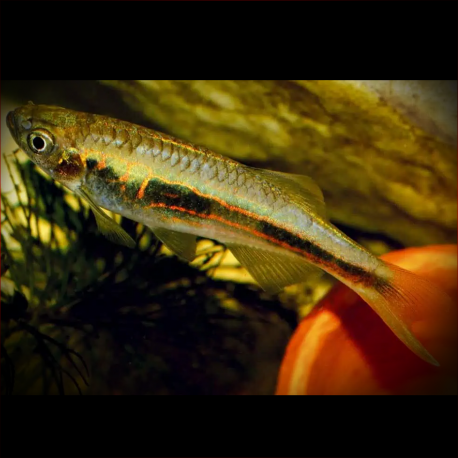More info
Datasheet
| Minimum Tank Size | 120 litres / 31.70 US gallons |
| Maximum Size | 7.5cm / 2.95inches |
| Temperature | 20°C / 68.00°F - 26°C / 78.80°F |
| Hardness | 1.01dgH / 18ppm - 8.01dgH / 143ppm |
| pH | 6.0-7.0 |
General Description
The Devario Chrysotaeniatus, a member of the Cyprinidae family, is a lesser-known species in the aquarium world, making an appearance only in 2005 with rare sightings since then. It boasts unique characteristics such as a complete lateral line, absence of infraorbital process, and distinctive patterns on its body and fins. This fish can grow up to a maximum size of 7.5cm and is classified under the order Cypriniformes.
Aquarium Setup
Creating an aquarium environment that mimics a flowing stream or river is vital for the well-being of the Devario Chrysotaeniatus. A substrate of rocks, sand, and gravel alongside driftwood or branches is recommended. Hardy aquatic plants like Microsorum or Anubias can be added to enhance the setup, although maintaining pristine water conditions and adequate oxygen levels is crucial. Regular 30-50% water changes are necessary, and a securely-fitted cover is essential due to the species' jumping tendencies.
Behaviour
This species is not aggressive but its constant activity and vigorous feeding may disturb slower or timid tankmates, making it more suitable for larger aquaria with robust, similarly-sized fishes. Known to school naturally, it is advised to keep Devario Chrysotaeniatus in groups of at least 8-10 specimens to reduce stress and enhance the aesthetic appeal of the display. In a group setting, any aggression is typically contained as individuals focus on maintaining their hierarchical positions within the school.
Feeding and Diet
Devario Chrysotaeniatus is an adaptable feeder, accepting various foods in captivity. While a quality dried diet can serve as a staple, supplementing with live or frozen offerings such as bloodworms, Daphnia, and Artemia is recommended for optimal coloration and health. Providing a diverse diet ensures the fish's nutritional needs are met, contributing to their overall well-being.
Reproduction & Dimorphism
As egg-scattering free spawners, Devario Chrysotaeniatus exhibits no parental care during reproduction. With proper conditioning and a well-prepared breeding tank, spawning can occur naturally. Females, distinguished by a rounder belly, are typically larger and less colorful than males. During mating displays, nuptial males develop vibrant orange pigmentation on the lower body and caudal fin, showcasing their breeding readiness.
Habitat and Distribution
Native to high-altitude habitats receiving ample rainfall, Devario Chrysotaeniatus is typically found in hill streams and small rivers with gravel substrates and vegetation. Originating from regions close to Manzhuo and Jinghong in southwestern China, as well as parts of Laos and Thailand, this species thrives in varying water flows and conditions within the upper Mekong watershed.

